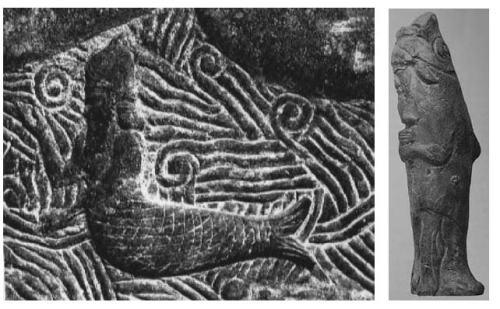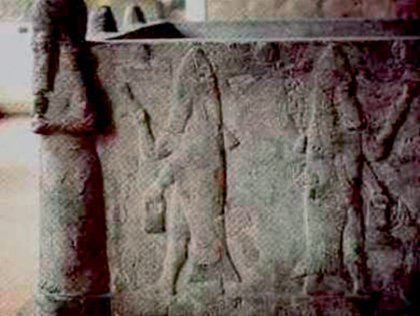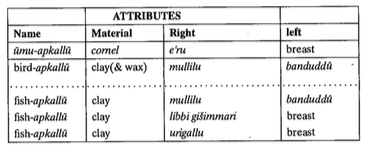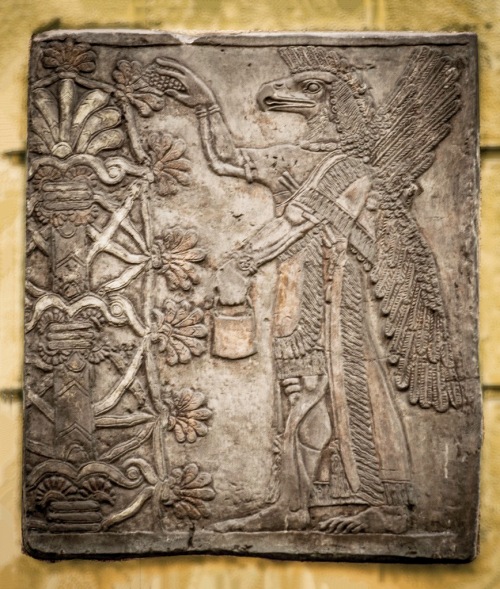On the Fish-Apkallu
“Lamaštu amulets:
The fish-apkallū on Lamaštu amulet 2 (and 4?), exactly like the ūmu-apkallū on Lamaštu amulets 3 and 61, has his left hand on the bed of the sick man. The right hand is slightly damaged, but probably greeting.

Fish-Apkallu statuettes of the type that were buried in the foundations of buildings. It is difficult to tell whether they hold their hands in a prayerful position or hold something indistinct.
Wrong hand:
Occasionally apkallū are attested holding the bucket in their right hand: AfO 28 57f. 30 (above IIiI/6), Lamaštu amulet 5 (?), Calmeyer Reliefbronzen 66 H:8 (bird-apkallū).
Unidentified object:
One of the apkallū on CANES 773 holds in his right hand an unidentified feather-like object.
Identification:
The identification of the fish-apkallū of ritual I/IiI with the “fish-garbed” man goes back to Smith JRAS 1926 709 (based on comparison with the Kleinplastik from Ur); identification of one of them with Oannes has been proposed since the early days of Assyriology (Kolbe Reliefprogramme 26, Zimmern KAT 535ff., ZA 35 151ff.) but was proved only after the names of the sages in Berossos’ Babyloniaka were recognized in cuneiform (van Dijk UVB 18 46ff.).
Occasionally the apkallū is mistakenly identified with the fish-man / kulullû (see below, VII.C.9), a completely different figure. U4 – a n (Oannes) and Adapa, a human sage living approximately at the same time, are probably two different figures (Borger JNES 33186, Picchioni Adapa 97ff.).

A “fish-man” / kulullû is depicted at left, and a fish-apkallū at right.
Wiggermann distinguishes these two entities.
The texts clearly indicate that the fish-apkallū are not fish-garbed priests, but mythological figures, man and fish; they are bīnūt apsî, “creatures of apsû“, in ritual I/IIi, purād tāmti … ša ina nāri ibbanú, “carp of the sea…who were grown in the river” in text IIiI.B.8 (cf. also Cagni Erra, I 162), and Berossos clearly describes them as a mixture of fish and man (cf. S. Mayer Burstein SANE I/5 13, 19).
Their names lack the determinative DINGIR, they are no gods, and the horns on the head of the fish (on palace reliefs, not on seals, cf. Kleinplastik 89, FuB 10 35) probably developed from its gills.
Berossos calls them “hemidaimones” (Jacoby FGrH 400).

Fish-Apkallū depicted on a cistern. The fish iconography is unmistakable, as are the banduddu buckets in their left hands. Objects in their right hands are indistinct, but the traditional gestures of warding or blessing seem clear. The objects in their right hands may be the “angular objects” mentioned in the table by Wiggermann at the top of the page.
History.
In the third millennium a b g al is the name of a profession: see MSL 12 10:15, ZA 72 174 11 v 3, Bauer AWL 125 i 4 (NUN.ME.KA X ME/GANA2f, cf. also Barton MBI 2 iv 2), Ukg. 6 ii 30′, iii 4 (NUN.ME.KA X ME/GANA2f.) UET 8 33:15 and for the same profession in the divine world: TCL 15 10:98 (dA b g a l) cf. 85.
In OB sum. incantations a b g a l apparently refers to a mythological sage at the court of Enki: VAS 17 13:5 (together with Enkum, Ninkum, and the seven children of Apsû), 16:11, 32:21, HSAO 262:56, PBS I/2 123:9 IIIISET 1 217 Ni 4176:12, OrNS 44 68, cf. ASKT 12 Obv. 11ff.
The “seven apkallū of Eridu“, at least in AnSt 30 78 (SB) identified with the seven antediluvian sages (Anenlilda is among them), are rooted in the third millenium (TCS 3 25:139, cf. Benito “Enki and Ninmah” and “Enki and the World Order” 91:105, and for later attestations JCS 21 11 25+a, Maqlû II 124, V 110 = AfO 21 77, VII 49, VIII 38).
The names of the seven antediluvian sages are certainly not as old as the names of the antediluvian kings: they seem to be derived partly from the titles of literary works (Hallo JAOS 83 175f.), and partly from the names of the antediluvian kings.
The element en-me-(e n) (and a m – m e, a m – i etc.) = e m e n (me —en) (cf. Finkelstein JCS 17 42, Wilcke Lugalbanda 41), “lord”, in the names of the kings has been reinterpreted as “the lord (e n) who makes good (d u 10 – g a)/ perfects (g a l a m) / refines (b ùl u g -g á) the regulations (m e)”.
Although the resulting names are good Sumerian (Lambert JCS 16 74), the consistent difference is telling. The Sumerian of the linguistically rather simple bilingual incantation to the fish-apkallū in bīt mēseri (III.B.8) could well be of MB date, and the Kassite seals with representations of the fish-apkallū prove that at this time the later views existed at least partially.
These undatable later views connect the named carp apkallū with canonized literature (Lambert JCS 16 59ff., Hallo JAOS 83 175f., van Dijk-Mayer BaMB 2 no 90) and have possibly been developed concomittantly.
Literature on the apkallū types :
Below text III.B.8, 9, 10, 11; Borger JNES 33 183ff., Foster OrNS 43 344ff., Komoróczy ActAntHung 21 135ff., 142ff., S. Mayer Burstein SANE 1/5 13ff., Kawami Iran 10 146ff., van Dijk UVB 18 43ff., all with many references to previous literature.”
F.A.M. Wiggermann, Mesopotamian Protective Spirits: The Ritual Texts, STYX&PP Publications, Groningen, 1992, p. 76-7.




